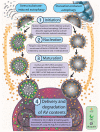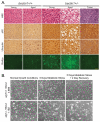Principles and current strategies for targeting autophagy for cancer treatment
- PMID: 21325294
- PMCID: PMC3075808
- DOI: 10.1158/1078-0432.CCR-10-2634
Principles and current strategies for targeting autophagy for cancer treatment
Abstract
Autophagy is an evolutionarily conserved, intracellular self-defense mechanism in which organelles and proteins are sequestered into autophagic vesicles that are subsequently degraded through fusion with lysosomes. Cells, thereby, prevent the toxic accumulation of damaged or unnecessary components, but also recycle these components to sustain metabolic homoeostasis. Heightened autophagy is a mechanism of resistance for cancer cells faced with metabolic and therapeutic stress, revealing opportunities for exploitation as a therapeutic target in cancer. We summarize recent developments in the field of autophagy and cancer and build upon the results presented at the Cancer Therapy Evaluation Program (CTEP) Early Drug Development meeting in March 2010. Herein, we describe our current understanding of the core components of the autophagy machinery and the functional relevance of autophagy within the tumor microenvironment, and we outline how this knowledge has informed preclinical investigations combining the autophagy inhibitor hydroxychloroquine (HCQ) with chemotherapy, targeted therapy, and immunotherapy. Finally, we describe ongoing clinical trials involving HCQ as a first generation autophagy inhibitor, as well as strategies for the development of novel, more potent, and specific inhibitors of autophagy.
©2011 AACR.
Figures





References
-
- Kuma A, Mizushima N. Physiological role of autophagy as an intracellular recycling system: with an emphasis on nutrient metabolism. Semin Cell Dev Biol. 21:683–90. - PubMed
Publication types
MeSH terms
Substances
Grants and funding
- 1K23CA120862-01A2/CA/NCI NIH HHS/United States
- RC1 CA147961/CA/NCI NIH HHS/United States
- CA111456/CA/NCI NIH HHS/United States
- R01CA130893/CA/NCI NIH HHS/United States
- K23 CA120862/CA/NCI NIH HHS/United States
- RC1CA147961/CA/NCI NIH HHS/United States
- P50 CA097257/CA/NCI NIH HHS/United States
- U01 CA132194/CA/NCI NIH HHS/United States
- CA83817/CA/NCI NIH HHS/United States
- R37 CA053370/CA/NCI NIH HHS/United States
- R01 CA083817/CA/NCI NIH HHS/United States
- P50CA097257/CA/NCI NIH HHS/United States
- R37CA53370/CA/NCI NIH HHS/United States
- R01 CA130893/CA/NCI NIH HHS/United States
- R01 CA111456/CA/NCI NIH HHS/United States
LinkOut - more resources
Full Text Sources
Other Literature Sources
Medical

